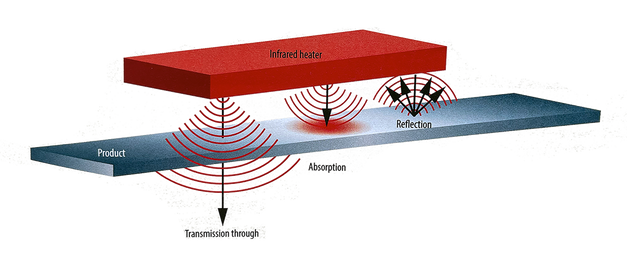|
WHAT IS INFRARED? Infrared radiation, also referred to as infrared light or infrared waves, is a form of energy with frequency and wavelengths just below the visible light portion of the electromagnetic spectrum. Infrared was discovered by William Hershel in the 19th century while conducting experiments that measured the difference in temperature between the colors in the visible light spectrum. Herschel chose the name infrared, which is Latin for ‘below’ because he believed that they were located ‘below the red light’ on the spectrum. While the human eye cannot see infrared waves, we can feel infrared energy as heat. Any object with a temperature greater than 0°K will radiate infrared energy, however, the two of the most obvious sources of infrared are fire and the sun. INFRARED USAGE Electric infrared heat is used in many industrial and commercial process heat applications as a way to quickly and efficiently heat materials, by penetrating directly through the air to the target. These IR waves are directly impinged on the target without heating the surrounding air, such as would occur in a convection oven. IR energy is converted to heat when it strikes and is absorbed by an opaque object. Electric infrared is generated by sending electricity through IR emitters, such as IR lamps or quartz tubes, and other resistance media. The emitter becomes very hot and emits invisible infrared heat waves. As the temperature of the heat source increases, infrared energy output increases to the 4th power of the emitter temperature. Therefore, IR heaters/emitters are extremely efficient, due to this law of physics (reference Stefan-Boltzmann Law), no requirement to heat the surrounding air, and relatively instant on/off control. TYPES OF IR WAVES There are three types of infrared waves, each with its own characteristics.
Classifying an infrared emitter as long, medium or short wave enables the ability to quickly determine the approximate wavelength range as measured in microns. When infrared is applied to an object, the energy is either absorbed, reflected or transmitted. The spectral characteristics and energy output of infrared are important factors to consider to determine which wavelength will produce the most effective and energy efficient heating process. Some heat processing applications are forgiving and can work well with long, medium or short wave infrared. However, there are certain applications that require a more tedious match for a successful heat process. Choosing the right wavelength can make a tremendous difference in overall efficiency, accuracy and speed of the process. In addition, emissivity, color sensitivity and absorption are all characteristics that determine which infrared wavelength is needed to achieve the best results. We are proudly the oldest and largest manufacturer of electric infrared equipment. Our story begins in 1917, when we started out manufacturing replacement fenders and running boards for the automobile industry. Today, Fostoria remains dedicated to providing our customers with the most uniform heat possible and top-of-the-line infrared and process heat equipment.
We’d love to hear from you. To learn more about the capabilities of infrared, or to discuss your specific heat requirements, give us a call or email us at [email protected].
0 Comments
Your comment will be posted after it is approved.
Leave a Reply. |
Copyright © 2024. Fostoria Infrared
All Rights Reserved.
Articles & Info | Legal Disclaimer
All list prices are suggested and shown in U.S. Dollars.
Pricing is subject to change without prior notice.
An equal opportunity employer.
Business Hours: M - F, 8:00am - 5:00pm EST | Closed on major U.S. holidays.
When ordering replacement parts, if your order qualifies for tax exempt status, contact factory ( 020821 )
1-800-682-3398 | www.tpicorp.com | [email protected]
All Rights Reserved.
Articles & Info | Legal Disclaimer
All list prices are suggested and shown in U.S. Dollars.
Pricing is subject to change without prior notice.
An equal opportunity employer.
Business Hours: M - F, 8:00am - 5:00pm EST | Closed on major U.S. holidays.
When ordering replacement parts, if your order qualifies for tax exempt status, contact factory ( 020821 )
1-800-682-3398 | www.tpicorp.com | [email protected]



 RSS Feed
RSS Feed
